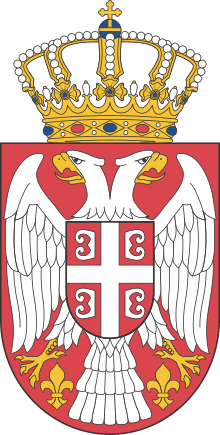Jablanica (river)
The Jablanica (Serbian Cyrillic: Јабланица, pronounced [jablǎnitsa]) is an 85-kilometre-long (53 mi) river in southern Serbia.[1] A left tributary of the South (or Južna) Morava river, it gives its name to the region of Jablanica and to modern Serbia's Jablanica District, with the region contributing about one third of the district's area.
| Jablanica | |
|---|---|
| Location | |
| Country | Serbia |
| Physical characteristics | |
| Source | |
| • location | Goljak |
| Mouth | |
• location | South Morava |
• coordinates | 43.12601°N 21.93084°E |
| Length | 85 km (53 mi)[1] |
| Basin size | 894 km2 (345 sq mi)[2] |
| Basin features | |
| Progression | South Morava→ Great Morava→ Danube→ Black Sea |
Origin
The Jablanica originates from the Goljak mountain, near the village of Grbavce, on the border with Kosovo. The area is rich in thermal springs, so several spas are located near the river: Stara Banja, Ravna Banja and Sijarina with popular Sijarinska Banja. At the village of Maćedonce Retkocersko the Jablanica receives the left tributary Čokotinska reka (Cyrillic: Чокотинска река), turns southeast and the region of Jablanica begins from that point.
Jablanica region
The upper Jablanica region is made of narrow river valley on the southern slopes of the Majdan and Radan mountains, in the westernmost corner of Jablanica District and near the border of the District of Priština in Kosovo. The river flows eastward, passing regional center of Medveđa and the villages of Rujkovac and Šilovo, before reaching the town of Lebane where the Jablanica enters the lower part of its valley and flows for the next 48 km in low Field of Leskovac, part of the depression of Leskovac, which itself is part of the composite valley of the Južna Morava. In the region, near Lebane, a famed archeological find of Caričin grad (Iustiniana Prima) is located.
The Jablanica flows next to the villages of Ždeglovo, Vranovce, Bošnjace, Turekovac and Stopanje, reaches Vinarce, the northern suburb of the city of Leskovac, and turns north. First it flows parallel to the Veternica river, to which it is connected by canal at the village of Zalužje, then parallel to the Južna Morava. After the villages of Dupljane and Pečenjevce it turns east and flows into the Južna Morava. From Pečenjevce, a parallel flow (canal) begins, connecting the Jablanica and Toplica rivers, some 15 km to the north.
Through Južna Morava, the Jablanica belongs to the Black Sea drainage basin, draining an area of 894 km2 (345 sq mi) itself.[2] It's not navigable and has an average discharge of 6 m³/s, which in rainy years grows much higher, so the river floods its valley causing much material damage. The name of the river, Jablanica, in Serbian means the Poplar river.
References
- Statistical Yearbook of the Republic of Serbia 2017 (PDF) (in Serbian and English). Belgrade: Statistical Office of the Republic of Serbia. October 2017. p. 16. ISSN 0354-4206. Retrieved 30 May 2018.
- Velika Morava River Basin, ICPDR, November 2009, p. 2
| Wikimedia Commons has media related to Jablanica (river). |
Further reading
- Mala Prosvetina Enciklopedija, Third edition (1985); Prosveta; ISBN 86-07-00001-2
- Jovan Đ. Marković (1990): Enciklopedijski geografski leksikon Jugoslavije; Svjetlost-Sarajevo; ISBN 86-01-02651-6
